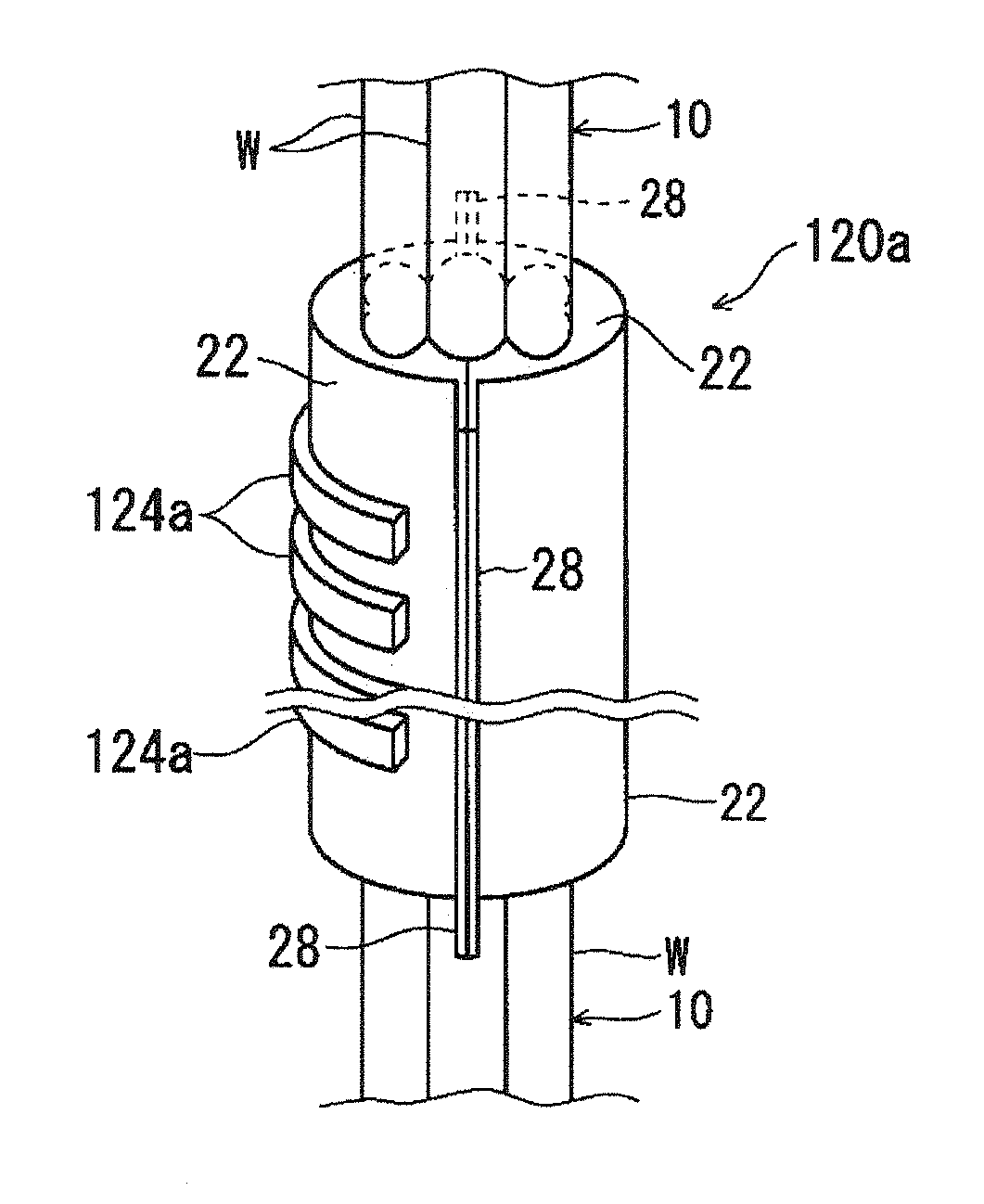Wire protection member
a technology of protection member and wire, which is applied in the direction of insulated conductors, inorganic insulators, cables, etc., can solve the problems of increasing the amount of nonwoven material that is required to form the wire protection member, sliding contact with a neighboring, and abrasion, so as to reduce the amount of nonwoven material usage, and increase the reach distance to the wire
- Summary
- Abstract
- Description
- Claims
- Application Information
AI Technical Summary
Benefits of technology
Problems solved by technology
Method used
Image
Examples
first embodiment
[0032]Hereinafter, a wire protection member 20a will be described (see FIGS. 1 and 2). This wire protection member 20a is formed so as to be able to cover the wire bundle 10. Here, the wire protection member 20a is formed by hot pressing a nonwoven material in a state in which it covers a portion to be protected of the wire bundle 10 in a longitudinal direction. However, it is also possible that the wire protection member 20a covers the entire wire bundle 10 in the longitudinal direction.
[0033]This wire protection member 20a has a main body portion 22 and a plurality of protruding portions 24a.
[0034]The main body portion 22 is a portion that is formed into a shape that covers an outer circumferential portion of the wire bundle 10 (see FIG. 1). Here, the main body portion 22 is formed so as to have an approximately circular outer circumferential shape when viewed in cross section (a plane approximately orthogonal to an extending direction of the wire bundle 10). An inner portion of...
second embodiment
[0052]In the wire protection member 20b the plurality of protruding portions 24b is formed as ridges on the main body portion 22 that extend in the extending direction of the wire bundle 10. That is to say, the wire protection member 20b has a shape composed of a series of alternating recessed and protruding portions in the circumferential direction of the main body portion 22. Here, these protruding portions 24b are provided in positions (other than the positions of the joint end portions 28) equiangularly spaced in the circumferential direction of the main body portion 22. For example, it is preferable that the protruding portions 24b are provided at intervals of 22.5 degrees.
[0053]Moreover, as shown in FIG. 5, each of the plurality of protruding portions 24b is formed into an approximately rectangular shape when viewed in cross section. However, alternatively, each of the plurality of protruding portions 24b may be formed into an approximately triangular shape, an approximately ...
third embodiment
[0058]In the wire protection member 20c the plurality of protruding portions 24c is formed so as to project from the outer circumferential portion of the main body portion 22 as raised dots. More specifically, these protruding portions 24c are provided in positions spaced apart from one another in the outer circumferential portion of the main body portion 22. Here, the protruding portions 24c are provided in positions spaced at approximately regular intervals in a plurality of rows extending in the circumferential direction of the main body portion 22 and in a plurality of columns extending in the extending direction of the wire bundle 10. However, it is also possible that these protruding portions 24c are provided at narrow intervals in an area where higher protection performance is required and at relatively wide intervals in a portion other than this area.
[0059]Moreover, the plurality of protruding portions 24c is formed as approximately cylindrical projections projecting from t...
PUM
| Property | Measurement | Unit |
|---|---|---|
| pressure | aaaaa | aaaaa |
| thickness | aaaaa | aaaaa |
| bending deformation | aaaaa | aaaaa |
Abstract
Description
Claims
Application Information
 Login to View More
Login to View More - R&D
- Intellectual Property
- Life Sciences
- Materials
- Tech Scout
- Unparalleled Data Quality
- Higher Quality Content
- 60% Fewer Hallucinations
Browse by: Latest US Patents, China's latest patents, Technical Efficacy Thesaurus, Application Domain, Technology Topic, Popular Technical Reports.
© 2025 PatSnap. All rights reserved.Legal|Privacy policy|Modern Slavery Act Transparency Statement|Sitemap|About US| Contact US: help@patsnap.com



